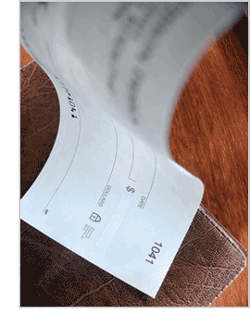Chapter 4:
Keeping Your Account in Good Standing
 The most basic and important aspect of checking account management is ensuring that there is enough money in your account to cover your transactions. Ultimately, keeping your account in good standing is your responsibility. The most basic and important aspect of checking account management is ensuring that there is enough money in your account to cover your transactions. Ultimately, keeping your account in good standing is your responsibility.
What happens if you do try to use your debit card or write a check when you do not have enough money in your account? That depends on the way your account is set up:
-
If you are not allowed to overdraw your account, your balance cannot go below zero. Your debit card transactions will be denied, and your checks will bounce. For each check that you bounce, you can be charged a NSF (non-sufficient funds) fee. If you frequently write bad checks, you could lose your account, and you could even be subject to legal actions.
- If you are allowed to overdraw your account, the next step depends on what type of overdraft protection you have;
Courtesy pay
This service covers you for transactions that otherwise would be denied because of insufficient funds, up to a set limit. At most financial institutions, you need to pay back the amount that was covered, or you could risk having your account closed. Typically you will be charged a fee for each time you use this service.
Overdraft transfer
If you don't have money in your checking account for a particular transaction, money will be transferred from your savings account or another checking account you own, or a charge for the overdraft will be made to your credit card. There will likely be a periodic fee for using this service and/or a limit to the number of times you can use it.
Overdraft line of credit
With an overdraft line of credit, your financial institution covers the amount you go into the negative on a transaction and then you pay them back. There are usually limits on the amount of money you can put onto the line of credit and also a limit on how frequently you can use it. Additionally, you will be expected to pay interest on the amount you pay back and you may have to pay a periodic charge just for having access to the line of credit.
Having the ability to overdraw, even if you have overdraft protection, does not relieve you of your duty to make sure you have enough money in your account to cover your transactions. Remember, when you overdraw your account, you are not given free money – you must pay back the amount you overdraw. People often get stuck in a vicious cycle where, because they have to pay back their overdrafts from the previous month, they continue to overdraw. If you find yourself in this cycle, try to revaluate your spending habits and/or look for ways to increase your income so that you can break out of it.
The best way to prevent overdrawing or bouncing checks is to monitor your account balance. Is it necessary to check your balance every time you want to buy a $1 pack of gum or $3 magazine? No, but it is a good idea to do so whenever you are not sure if there is enough money in your account. In this day and age, knowing your balance is a snap – most financial institutions will let you check it over the phone or on-line. (Remember to subtract from your balance the amount of any outstanding checks.) If you see that you don’t have enough money, don’t make the purchase. But what if you need to buy an essential, like gasoline or food? The ability to overdraw your account can come in handy in a pinch, but as mentioned above, it is better to manage your finances so that you do not need to do it.
Checking Account Ledger
If you do not feel comfortable checking your balance online or over the phone, you can also use the pen and paper method. Start with the opening balance. Every time you make a deposit, record it and add it to your balance. Every time you make a withdrawal (including writing a check, even if it has not yet been deposited), record it and deduct it from your balance. When you want to know your account balance, you can simply look at your sheet.

 |
